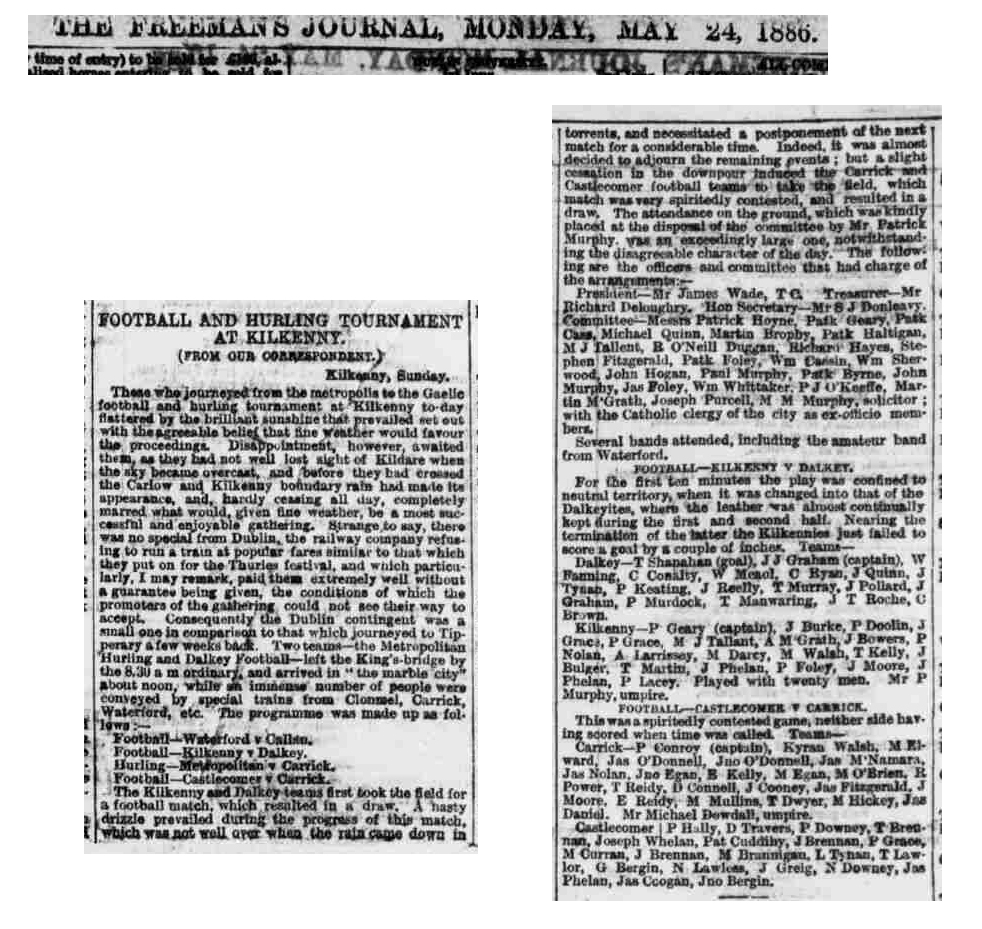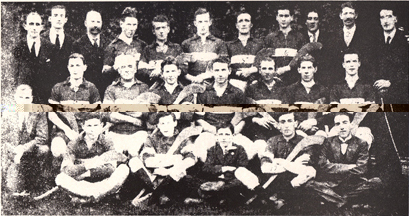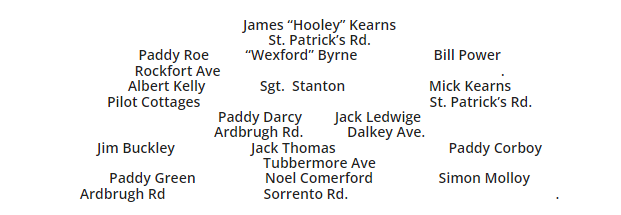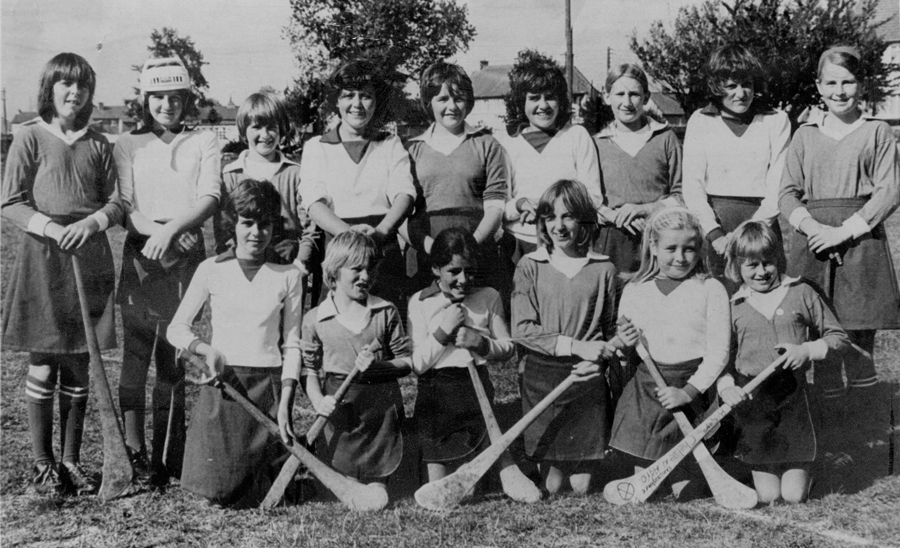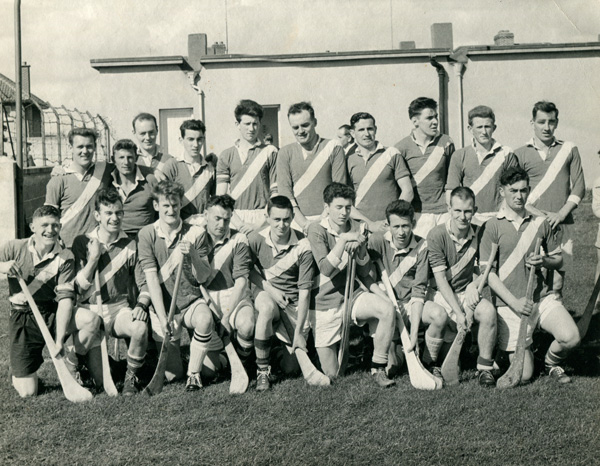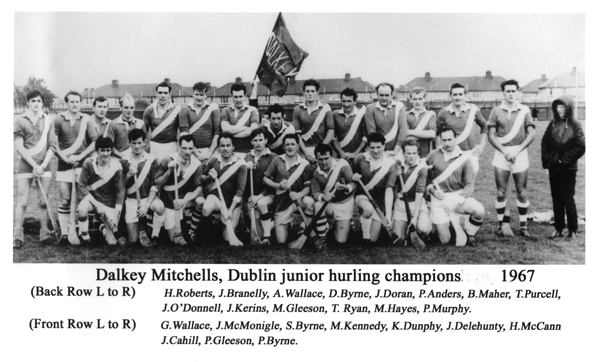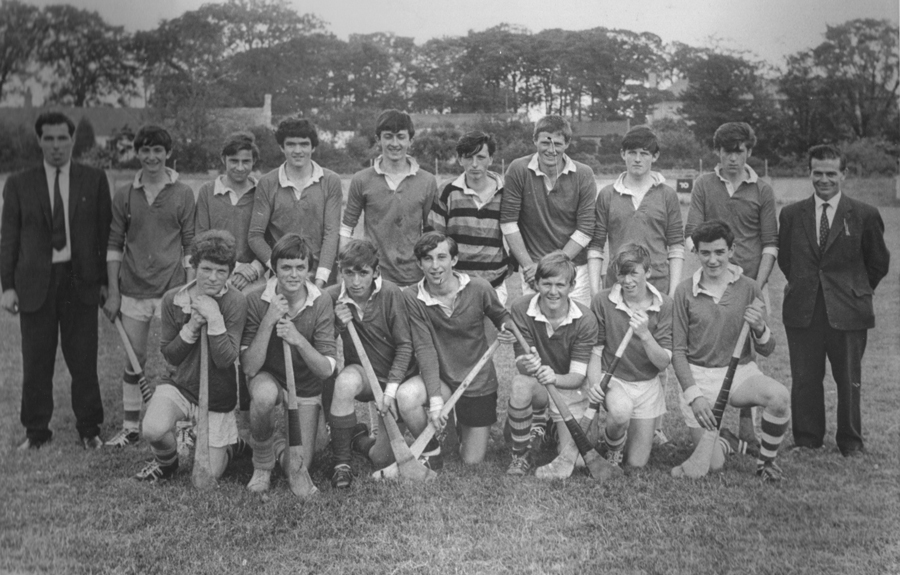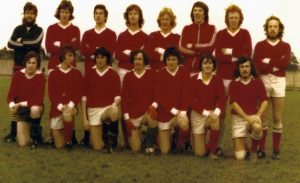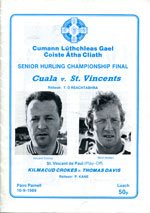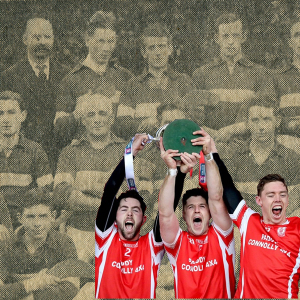Fadó, fadó
Cuala Hurling Club
Both Paddy Darcy and Charlie Somers took part in the 1916 Rising and were interned in England. We know from official records, that a “P.Darcy” from Woodside, Dalkey was transferred to Stafford on 8th May 1916 in the company of a large contingent (#203) from Wexford, mostly Enniscorthy – the makings of a hurling fraternity perhaps? A further #58 from Athenry, on 13th May, adds to the theory of what the main sporting interest might have been. Add to this the fact that the Somers family appear to have had Waterford roots (His mother Ellen (nee Walshe) and sister Elizabeth were born in Waterford. Though “Daniel Charles” (to give him in proper name) was born in Cork so the hurling DNA is beyond doubt.
Paddy Darcy was, in 1916, an 18 year-old living at 16, Ardbrugh Road the second youngest of 6 children of a Wexford man Abraham Darcy. Abraham was a retired Dublin Metropolitan Policeman. His mother was Elizabeth Darcy.
After their release in 1918, they formed the Cuala team.
Following the outbreak of the War of Independence, Charlie Somers was arrested, in 1920, and received a 10-year term of imprisonment in Dartmoor. The Somers family ran a Post Office in Tubbermore Avenue. When the Post Mistress, Mary Walshe, (his maternal aunt) died, Charlie was released on parole for her funeral and while in Dalkey, he played a match for Cuala. Shortly afterwards, a number of arrests followed and Cuala became inoperable as most of the team members were in jail.
The cuala Hurlers strugged on in the early 1920s, using the grounds at the “Firm” Quarry off Dalkey Avenue but due to emigration and lack of players, the team died-out in the late twenties. It was reformed again in the early thirties when young players became available. A Team that played in the Twenties/Thirties was as follows
St Mary’s Camogie Club
More than 12 players have played for Dublin and Leinster. A Cuala player has also captained the county team. (Cartlan Digiteach Cuala would like to hear full details please)
St. Begnets G.A.A. Club
St. Begnets G.A.A. Club, known to be active in 1917, was, it seems, re-launched in July 1959. Football teams from Minor down completed in the Cuala Marian League.
What is now Hyde Park G.A.A. pitch was dissected by a wall, and a soccer pitch was sited on the lower half of the field. A Junior Football section was formed in 1959. Access to Hyde Park was achieved in 1961 when U-13 and Junior Hurling matches were played. In 1962, Dun Laoghaire Borough Council voted to remove the wall at Hyde Park and it was demolished over a year later revealing the pitch as it is today.
Dalkey Mitchels
In August 1962 it was decided to change the club name to Dalkey Mitchell’s. The name was probably influenced by an earlier team called Glasthule Mitchels that were active in the late 1800s. The name, in common with many other clubs, was adopted in honour of the Irish nationalist activist, author, and political journalist.John Mitchel (1815- 1875). Famously banished to Van Diemens Land (Tasmania) when he published his widely read “Jail Journal”, local lore had it that his last sighting of Ireland was of Dalkey. Although he sailed as a prisoner from Kingstown to Spike Island and mentioned sighting of Bray Head and Vale of Shanganagh, there is no mention of any sightings of Dalkey.
In 1962, the J.H.L. Division C was won. This was the first adult competition ever won by a local club in County Board competitions. At least two men associated with this team (who) are still active in Cuala today. In 1964 work commenced on the dressing rooms in Hyde Park.
During the 60’s Dalkey Mitchell’s grew in strength. In 1967 the Junior Hurling Championship was won. The Intermediate Championship final was lost the following year. In 1969 Dalkey Mitchell’s were promoted to the Senior Hurling League, the first ever Senior Hurling Team in South County Dublin. They continued as an independent club until 1974.
Cuala Boys
In a meeting in the Town Hall in Dun Laoghaire February 1962, Cuala Boys GAA Club was founded under the Chairmanship of Richard Curran. This was a development grounded in the Cuala Marian League, a competition run for schools in south Dublin & north Wicklow. Members of Cuala Boys were drawn mainly from Dun Laoghaire C.B.S. But they also benefited from the disbandment of two neighbouring clubs – St Michael’s and Dun Laoghaire Commercials whos boys were amalgamated into the new club. They competed at U11 & U13, when they proved too strong for the local opposition. Their colours were blue with a white collar. The first set of jerseys were bought with the proceeds of a raffle, the prizes being a transistor radio (none of your MP3s or iPhones in them days!) , a ladies or gents bicycle and a quarter ton of coal. Tickets were 3d. each or five for a shilling. Most homes in Sallynogging subscribed.
Roger Casements
Roger Casement’s were formed in 1966 to cater for minors emerging from both Dalkey Mitchell’s and Cuala Boys. The club name was undoubtedly influenced by fact that the remains of Roger Casement were repatriated to Ireland the previous year for re-interrment in Arbour Hill. Many ceremonies were observed on that occasion including gatherings at his birthplace in Sandycove. At the time, Mitchell’s presented this new club with “twelve hurls as a gesture of goodwill”. They wore red and white and were based in Glasthule. By 1967 the boys had made it to a M.H.C. Final but were beaten by Air Corps (they flew young in those days). As often happens with amalgamations, it seems players from one of the constituent clubs, Cuala Boys emerged as the dominant group. Meanwhile, Dalkey Mitchell’s soldiered-on sucessfully, but the last reported activity of the Roger Casements Committee was on 21 June 1967 and it seems they found it difficult to sustain themselves. Time for further re-organisation!
Cuala Casements
In September 1967 Cuala Boys and Roger Casements provisionally amalgamated to become Cuala Casements Hurling & Football Club. The first meeting was attended by D. Curren (V.Chair), J. Robinson (Chair), M.Priest, P. Tracy, T. Holden, L. Owens, J. Canny (Asst.Sec), F Sullivan, B. Lambkin, J. Mooney, J.Reilly, P. Mohan, M McCauley and M. Dunphy (Sec). Red and White became the predominant colours. The merger was formalised at an Annual General Meeting held in December. At this time, the Cuala Bingo began in the Empire (later Astoria) Hall, Glasthule, (later to become Club Caroline, then the Forum Cinema – sadly now closed). It later moved to the Assembly Hall in Dun Laoghaire. For years it was the main source of income for the club. That same year the U.15 Hurling Championship was won and the Sallynoggin Pavilion, built by the parents of the players, was opened in September.
A newspaper report from 1969 states that there was “no shortage of players…however it is difficult to get suitable, competent officials to look after all the teams and generally it is the same four or five”. A unique treble was also achieved in 1969 with the U.15, U.16 and U.18 Hurling Championships. It was “a hell of a run”. Sallynoggin was the only hurling pitch available to the club at this time. The club fielded “a bit of a Junior Hurling team”.
The years 1970-72 also saw three U.21 Hurling Championship finals in a row being lost. In 1971 the Warwickshire Juvenile Board visited Cuala with a party of 30 players. Summer Leagues were organised in which the “the organisers wish to emphasise that this competition takes second place to events such as Scout outings, Cubs Altar Boys etc”. 1972 saw the J.H.C won by the club for the first time with a 3-10 to 0-11 victory over St. Vincents. It has been won three more times since then. The J.H.L was also won that year. Bingo was in the Top Hat in Dun Laoghaire. At this time the club adopted a policy of dealing with hurling exclusively until the players were 14 years old. Its also clear that from at least 1973, Cuala Casements had begun referring to itself as, just, Cuala.
Cuala GAA Club
Following agreement reached at its AGM on 13 Nov 1974, Cuala Casements amalgamated with Dalkey Mitchells to form Cuala Hurling & Football Club (a revised Constitution was agreed at a Special General Meeting held on 24 Mar 1976). Also in 1976, the I.H.C. was won restoring the club to the Senior ranks (previously achieved by Mitchell’s in ’69). This was the year in which the Hall on Hyde Road in Dalkey was bought for £24,000 from the dormant Dalkey Boxing Club. The hall had been built by local initiative, each house in the area paying for one brick.
Cuala Hurling, Football and Camogie Club
In 1978 the Club as we know know it took shape when the St Mary’s Camogie Club formally merged with their Dalkey neighbours. This marked a milestone in the club journey and the beginning of a period of growth and development including the opening of the Social Centre (1985), our first Senior Hurling Titles (1987 & 1989) Hyde Road pitch redevelopment (1989) and our third Senior Hurling Title (1991)
“Who Do You Think You Are?” – a Historical Timeline
Acknowledgements / Sources
Prionsais Ó Maoláin (RIP)
Fergus Ó Tighernaigh (RIP)
Michael Kennedy
Colmán Ó Drisceoil
Harry Roberts
P.J. Holden
Joe Dodd
Cartlann Digiteach Cuala (Cuala Digital Archive) was established in 2009 to assemble an on-line archive of images, stories and memorabilia relating to Cuala and its ‘ancestral’ clubs.
If you have any information or material to share with us, please contact –
Michael Goodwin, +353 (0) 87 2266140, history@cualagaa.ie
Contributors can be assured that all material will be kept safe, treated with care and returned promptly.
More History Articles


